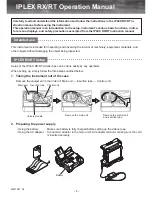
TECHNICAL DESCRIPTION AND OPERATING MANUAL ST131 <PIRANHA II> and ST131N
47
As an example, some possibilities of the smartphone are following:
• Work in almost all telecommunication standards: GSM, 3G, WLAN, BLUETOOTH and LTE (4G).
• Transmission of video.
• Preserving and subsequent transmission of audio and video data on the basis of the installed software.
For example, data compression, followed by transmission to an arbitrary time by LTE broadband channel.
When searching, the illegal device can be mistaken for legal because there was no obvious
distinguishing features.
Possibility of remote on/off on the STM transfer complicate it by detection and requires more
special additional measures, for example, creating a situation provoking insertion STM (the simulation
of an important meeting). Do not forget about the possible presence of secretly installed video cameras.
Options: from "forgotten" phone set - to number of specially made all range, highly sensitive
and high-energy devices.
Modern cell phone is transmitting:
• at the moment of establishing a connection with a base station;
• mainly, while sound presence at the phone (talk) after the connection is already established;
• while data transfer (e.g., SMS).
All the rest time the phone is receive-only. No radiation - no detection.
The same way search is complicated by the absence or long delays (up to several hours) the
broadcasting after blocking communication, for example, such as jammer devices.
CDMA
Detection of STM with this channel transmitting information is complicated with the following factors:
• Radiated power of phone set has a strict dependence on the distance from the base station with
a tendency to minimize it.
Being in close proximity to base station radiated power is no more than 10
µW (maximum – 200 mW).
• The emitted signal has a noise-like structure.
Based on these factors, it is recommended to choose the control of this standard in manual mode.
The spectrogram of the signal is similar to that shown in figure 35. Transition to the spectrogram by
pressing
. In this case the default display settings are optimized for this standard. Return to display
levels performed by secondary pressing on
.
GSM 900/1800, 3G
Specially manufactured STM based on this standard or
cellular handset can use any of these three ranges.
Therefore, for operative search, it is recommended to use
simultaneous viewing only these standards. This is done by pressing
the "GSM+3G" (Figure 47).
UMTS (3G) signals have CDMA noise-like structure.
Figure 47
















































